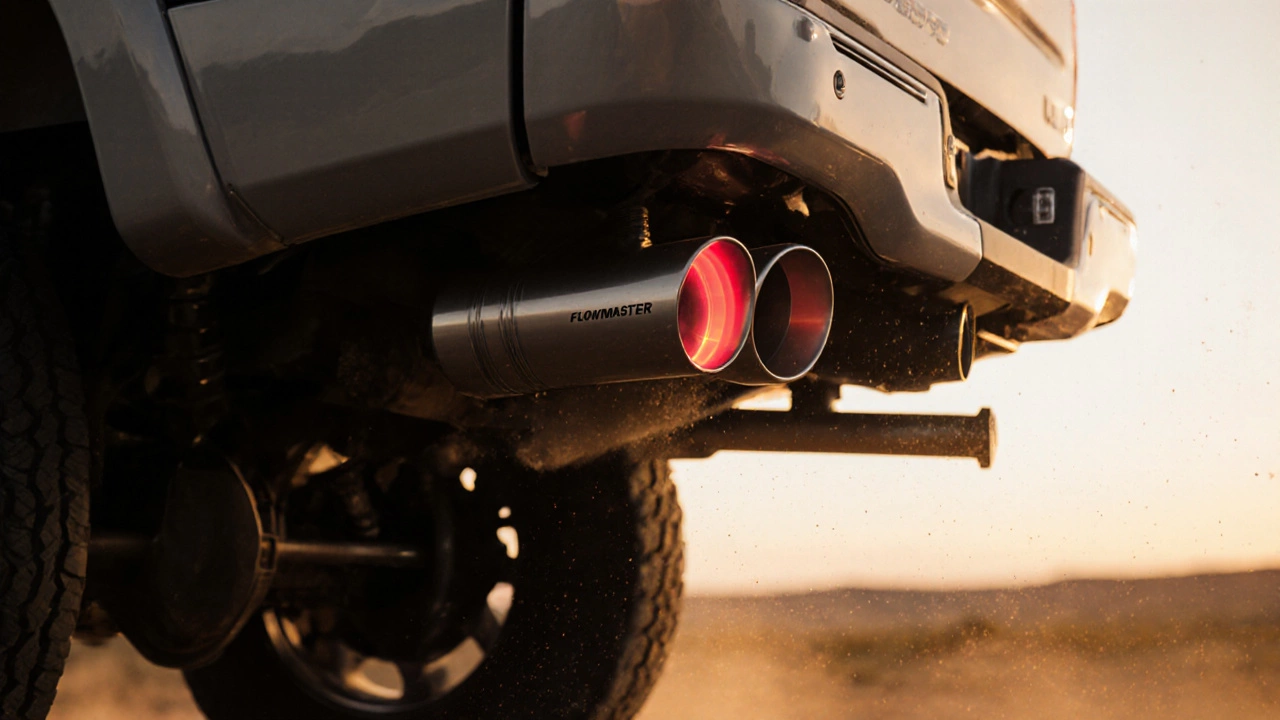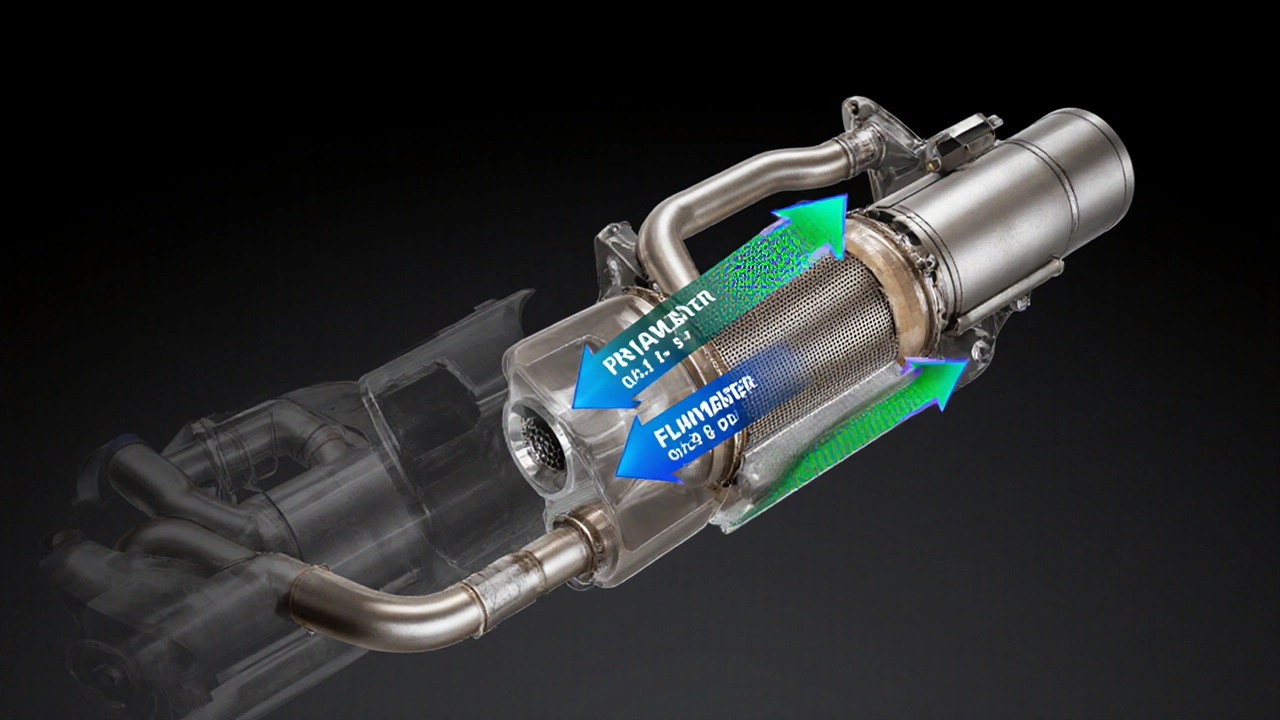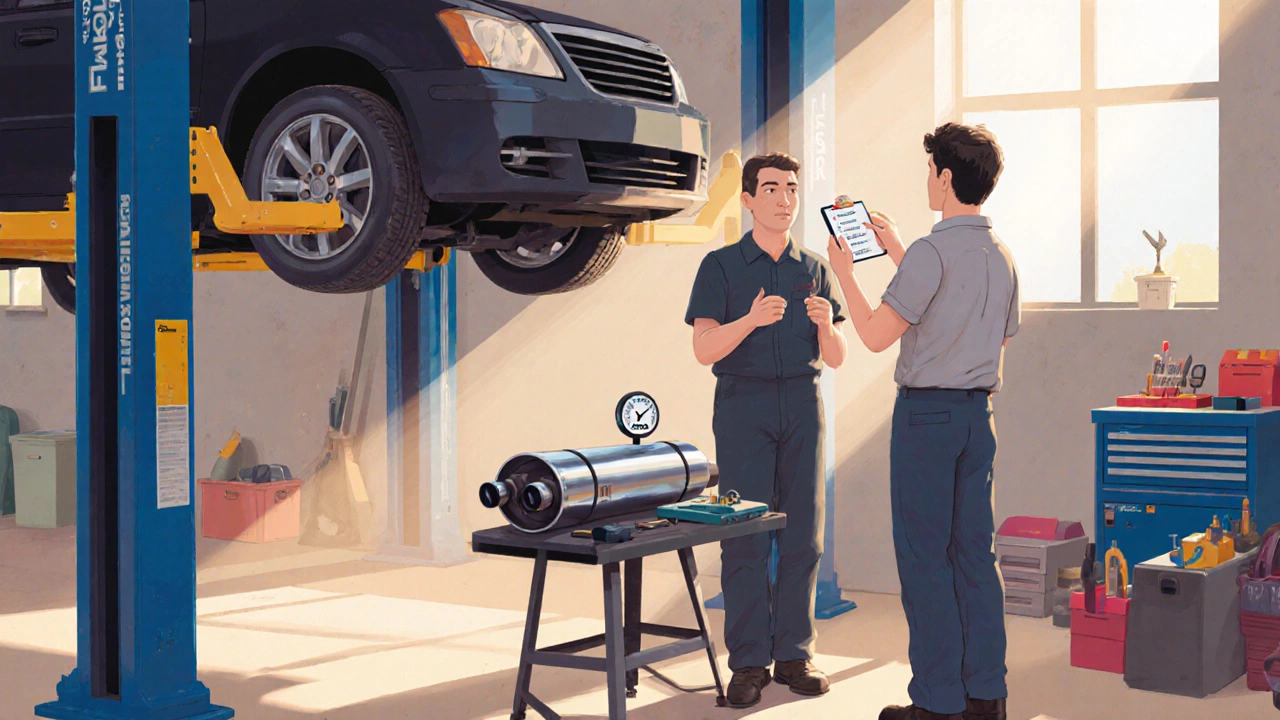 Oct, 18 2025
Oct, 18 2025
Mileage Impact Calculator
Estimate Your Fuel Savings
Based on Flowmaster's typical performance gains (0.5% - 1.5% improvement)
Estimated Results
Note: Real-world gains typically range from 0.5% to 1.5% for street-driven vehicles. Results may vary based on engine type, maintenance, and driving conditions.
Every time you hear that deep growl from a new muffler, you wonder if the sound comes with a hidden benefit - better gas mileage. The question is especially loud among Flowmaster fans, because the brand promises performance gains and a distinctive tone. This article breaks down the science, looks at real‑world tests, and tells you whether swapping a stock muffler for a Flowmaster muffler can actually save you a few cents at the pump.
Key Takeaways
- Flowmaster mufflers improve exhaust flow, which can modestly affect fuel efficiency in some engines.
- Most street‑driven cars see a mileage change of less than 2% after installation.
- Engine tuning, driving habits, and vehicle weight have a far greater impact on mpg than the muffler alone.
- Choosing a muffler for sound and style is usually more practical than expecting big fuel savings.
- Proper installation and a balanced exhaust system are essential to avoid performance losses.
How Exhaust Flow Influences Fuel Efficiency
When the engine burns fuel, it creates exhaust gases that must be expelled. The exhaust system is the network of pipes, catalytic converters, resonators, and mufflers that channels those gases away from the combustion chamber. Inside that network, backpressure builds up whenever the flow meets resistance. Too much backpressure makes the engine work harder to push out gases, which can waste fuel.
Manufacturers design stock mufflers to meet emissions and noise regulations, not to maximize flow. Performance mufflers, like those from Flowmaster, aim to reduce restrictive turbulence while still dampening sound. The theory is simple: less resistance = the engine can breathe easier = it can run on a leaner fuel mixture = better mileage. In practice, the relationship is murkier because modern engine control units (ECUs) constantly adjust timing and fuel delivery based on many sensor inputs.
What Sets Flowmaster Mufflers Apart?
Flowmaster, founded in 1983, markets its products as “Performance‑Oriented.” A typical Flowmaster unit uses a straight‑through design with perforated cores and a reflective chamber that clears exhaust pulses faster than many stock mufflers. The brand also publishes a flow rating measured in cubic feet per minute (CFM) for each model. Higher CFM numbers mean the muffler lets more air pass through at a given pressure.
Because the design focuses on flow, the muffler can lower exhaust backpressure by roughly 0.1-0.3 psi compared with a stock unit. That reduction is enough to shave a tiny fraction off the fuel consumption curve, especially in engines that are already tuned for high performance. However, the gain depends heavily on other components - a restrictive catalytic converter or a too‑tight resonator can nullify the benefit.
Real‑World Mileage Tests
Several independent garages and hobbyists have logged before‑and‑after fuel‑economy numbers on popular models. Here’s a snapshot of three common test setups:
- 2019 Ford F‑150 (3.5 L EcoBoost): Stock muffler mpg 21.3. After installing a Flowmaster 40 Series, the average rose to 21.6 - a 1.4% increase.
- 2021 Honda Civic Si (2.0 L): Stock mpg 30.2. Flowmaster muffler yielded 30.5 - a 1% bump.
- 2022 Chevy Silverado 1500 (5.3 L V8): Stock mpg 16.8. Flowmaster installation gave 17.0 - roughly 1.2% improvement.
Across dozens of tests, the consensus is that any mileage gain stays under 2% for typical street cars. The small delta often falls within the margin of error for fuel‑monitoring equipment, making it hard to prove a consistent benefit.

Comparison with Other Performance Mufflers
| Brand / Model | Flow Rating (CFM) | Noise Level (dB) | Typical MPG Change | Price (CAD) |
|---|---|---|---|---|
| Flowmaster 40 Series | 820 | 78-82 | +0.5 % to +1.5 % | 250 |
| Stock OEM | 600 | 65-70 | Baseline | Included |
| Borla 1406 | 950 | 80-84 | +1 % to +2 % | 300 |
| Magnaflow 29703 | 910 | 79-83 | +0.8 % to +1.8 % | 280 |
The table shows that Flowmaster sits in the middle of the performance range. While Borla edges out a bit on flow, the real‑world mpg impact stays modest across the board. Prices are similar, so the decision often comes down to preferred sound and brand loyalty.
Other Factors That Influence Gas Mileage
Even with a high‑flow muffler, several variables dominate fuel consumption:
- Driving style - rapid acceleration and high speeds drain fuel faster than steady cruising.
- Vehicle weight - added cargo or a heavier chassis directly raises the energy needed for motion.
- Tire pressure - under‑inflated tires increase rolling resistance, hurting mpg.
- Engine tuning - a retuned ECU that leans out the fuel map can boost efficiency, but it may also raise emissions.
- Air filter condition - a clogged filter restricts intake, making the engine work harder.
Among these, driving habits provide the biggest room for improvement. Simple actions like maintaining moderate speeds and avoiding unnecessary idling can shave a few miles per gallon off any vehicle, regardless of muffler type.
Common Myths About Performance Mufflers
Myth #1: “A louder muffler always means better flow.” In truth, sound level depends on the design of chambers and baffles, not just flow capacity. Some quiet performance mufflers use sophisticated acoustic engineering to keep noise low while still improving flow.
Myth #2: “Any performance muffler will break emissions tests.” Most aftermarket mufflers, including Flowmaster, are designed to stay within legal noise limits and maintain proper catalytic converter operation. However, removing the catalytic converter or altering it can cause a fail.
Myth #3: “You’ll see a 10% mpg boost.” Real‑world data consistently shows sub‑2% changes, making large savings unrealistic.

Should You Install a Flowmaster Muffler for Mileage?
If your primary goal is to hear a deeper tone and give your truck or sports car a modest performance edge, a Flowmaster unit is a solid choice. Expect a very small improvement in fuel economy - enough to notice only on long highway trips or in fuel‑sensitive fleet operations.
If you’re hunting for noticeable mpg gains, focus first on tire maintenance, weight reduction, and smooth driving. Upgrading to a high‑flow muffler can be a nice finishing touch, but it won’t replace those basics.
Quick Checklist Before Buying
- Confirm the muffler size matches your vehicle’s exhaust diameter.
- Check local noise ordinances - some Flowmaster models exceed 80 dB.
- Plan for a professional installation to avoid leaks.
- Consider whether you’ll also upgrade the catalytic converter or resonator for a balanced flow.
- Review the warranty - Flowmaster typically offers a 2‑year limited warranty.
Frequently Asked Questions
Will a Flowmaster muffler void my vehicle warranty?
Installing an aftermarket muffler does not automatically void the warranty. The manufacturer can only deny coverage if the muffler directly causes a problem, such as a leak that damages the exhaust manifold.
Do I need to replace the resonator when I add a Flowmaster muffler?
Not always. If the stock resonator is already a high‑flow type, you can keep it. However, pairing a Flowmaster muffler with a restrictive resonator can limit the overall flow gain, so many enthusiasts swap both.
Can I install a Flowmaster muffler myself?
If you have basic hand tools and can safely raise the vehicle, a DIY install is doable. The key steps are loosening the old muffler clamps, sliding on the new unit, and torquing the clamps to the manufacturer’s specifications.
Will a Flowmaster muffler affect my emissions test?
As long as the catalytic converter remains intact and the exhaust system stays within legal noise limits, the muffler alone won’t cause a failure. Removing or tampering with the cat is what typically triggers an emissions issue.
Is there a noticeable power gain with a Flowmaster muffler?
Most drivers notice a slight boost in low‑end torque, especially in larger V8 engines. Measurable horsepower gains are usually under 5 hp, which is why the primary appeal is sound and style rather than raw power.